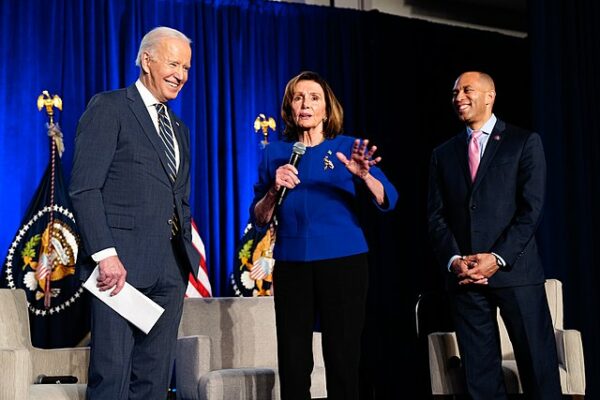
“A blockbuster.” “Blowing past expectations.” “Boom!” That’s what the headlines across the country read this morning when the Bureau of Labor Statistics released its monthly jobs report on Friday.
CNBC wrote, “The U.S. economy added far more jobs than expected in September, pointing to a vital employment picture as the unemployment rate edged lower, the Labor Department reported Friday.
Nonfarm payrolls surged by 254,000 for the month, up from a revised 159,000 in August and better than the 150,000 Dow Jones consensus forecast. The unemployment rate fell to 4.1%, down 0.1 percentage point.
With upward revisions from previous months, the report eases concerns about the state of the labor market and likely locks in the Federal Reserve to a more gradual pace of interest rate reductions. August’s total was revised up by 17,000, while July saw a much larger addition of 55,000, taking the monthly growth up to 144,000.
‘It was ‘wow’ across the board, much stronger than expected,’ Kathy Jones, chief fixed income strategist at Charles Schwab, said of the report. ‘The bottom line is it was a very good report. You get upward revisions and it tells you the job market continues to be healthy, and that means the economy is healthy.’”
Despite what people all over the country have experienced over the past few years, the government agency’s report was likely welcome news to the Kamala Harris campaign. Finally, they thought, Bidenomics was really working. The jobs report could pull the Democrat across the finish line.
While the report was celebrated by liberals, one eagle-eyed economics writer pointed out that the unexpected lowering in unemployment came from the government hiring hundreds of thousands of new employees, gaming the report from the BLS to help Harris.
Instead for now let’s focus on the parts of the jobs report which the BLS has traditionally used to mask headline weakness, such as part-time workers used to mask weakness in full-time jobs, or foreign-born workers surging at the expense of native-born. Well, this month there was little of that as well, and in fact, part-time workers dropped modestly as full-time workers rose while native-born workers actually rebounded from a five year low as foreign-born workers A dropped from an all-time high.
And yet, it didn’t take long to find what the BLS did this time to make the jobs appear much stronger than expected, a political imperative for the highly politicized agency tasked with making the Kamala/Biden economy appear stronger than it was exactly one month ahead of the election.
The answer, ironically, was in the number of government workers, which exploded higher, and were not only instrumental in pushing the Household Survey print much higher, but meant the difference between a 4.1% and 4.5% unemployment rate.
Here is what happened.
In September, the number of government workers as tracked by the Household Survey soared by 785K, from 21.421 million to 21.216 million, both seasonally adjusted (source: Table A8 from the jobs report). This was the biggest September surge in government workers on record (excluding the outlier print in June 2020 which was a reversal of the record plunge from the Covid collapse months before).
The writer goes on to explain that although government workers soared by the most on record, private workers only saw modest gains, “a far more believable number, and one which however would indicate that the recent labor market malaise continues.”
The addition of tens of thousands of government jobs has been called a new tactic after the Labor Department was accused over the summer of simply lying about the number of jobs added in order to help the Biden administration.
In August, The New York Times reported that “the U.S. economy added far fewer jobs in 2023 and early 2024 than previously reported, a sign that cracks in the labor market are more severe — and began forming earlier — than initially believed.
On Wednesday, the Labor Department said monthly payroll figures overstated job growth by roughly 818,000 in the 12 months that ended in March. That suggests employers added about 174,000 jobs per month during that period, down from the previously reported pace of about 242,000 jobs — a downward revision of about 28 percent.
The updated numbers are the latest sign of vulnerability in the job market, which until recently had appeared rock solid despite months of high interest rates and economists’ warnings of an impending recession. More recent data, which wasn’t affected by the revisions, suggests job growth slowed further in the spring and summer, and the unemployment rate, though still relatively low at 4.3 percent, has been gradually rising.
This year’s revision was unusually large. Over the previous decade, the annual updates had added or subtracted an average of about 173,000 jobs.”
Why the Bureau of Labor Statistics was so off has come under scrutiny from House Republicans. The Chairman of the House Jodey Arrington said, “Based on more comprehensive data released from state unemployment tax records, the Biden Bureau of Labor Statistics acknowledges they were way of on the number of new jobs created between March of 2023 and March of 2024 by almost one million or 30%, which is five times their average margin of error.”
Former president Donald Trump labeled the revision a “fraud” against the American public.
“They don’t mention the economy because the economy’s horrible,” Trump said in a phone call with Fox News. “They defrauded the people of our country with the job numbers. You saw that? 818,000 fake jobs they put in the rolls.”
“They thought they were going to keep those numbers until right after the election, when they could announce a revision… They were fraudulent job numbers,” he added.
[Read More: FEMA Claims Running Out Of Money]











